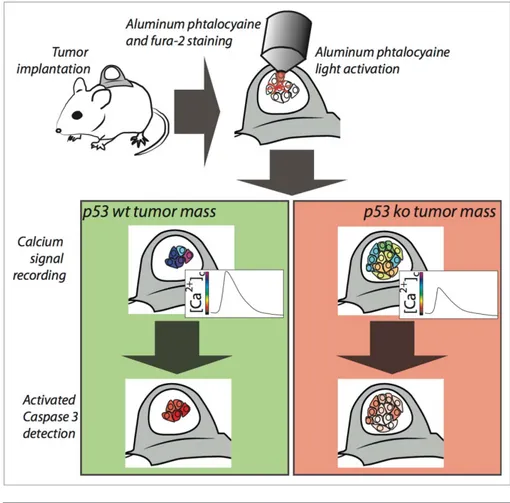Inside the tumor: p53 modulates calcium
homeostasis
Carlotta Giorgiy, Massimo Bonoray, and Paolo Pinton*
Department of Morphology; Surgery and Experimental Medicine; Section of Pathology; Oncology and Experimental Biology and LTTA center; University of Ferrara; Ferrara, Italy
yThese authors equally contributed to this work.
Calcium (Ca2C) is an essential element of signal transduction. Ca2C signaling is involved in various cellular processes, such as proliferation and apoptosis and thus is also crucial in cancer. In particular, modu-lation of Ca2Csignaling can change cells’ sensitivity to apoptotic signals, such as chemotherapeutic agents.1
Previous studies indicate that both tumor-suppressors (PML, PTEN, Bax) and oncogenes (Bcl-2, Ras, Akt) are able to regulate Ca2Cdependent apoptosis by modulating Ca2C release from the endo-plasmic reticulum (ER) store.2 In turn, these factors can mediate the opening of the mitochondrial permeability transition pore.3
In contrast, little information was available on the transformation-related protein 53 (TRP53), better known as p53 in the regulation of Ca2-dependent apo-ptosis. This oncosuppressor becomes acti-vated in response to a myriad of stressors, and its activity is crucial for the regulation of cell death pathways. Since the p53s prominent pro-apoptotic role was demon-strated, the mechanism through which p53 mediates apoptosis has been a matter of intense study. Numerous publications have described the importance of p53 in both extrinsic and intrinsic apoptotic pathways.4
In a recent study we demonstrated that p53 is present at the ER and
mitochon-dria-associated membranes (MAMs),
where it becomes enriched upon activa-tion. At these sites, p53 interacts with the C-terminal portion of the sarco/ER Ca2C¡ATPase (SERCA) pump, changing
its oxidative state and, in turn, increasing ER Ca2Cloading. Furthermore, p53 acti-vation enhances ER Ca2C transfer to mitochondria, thus triggering pro-apopto-tic mitochondrial Ca2C overload and mitochondrial morphological alterations, leading to release of pro-apoptotic factors. Consistently, pharmacological p53 inacti-vation, as well as naturally occurring loss-of-function mutations of p53, inhibit p53s ability to increase Ca2Csignaling to the mitochondria, and allow for its onco-genic function.5
Whereas most of the mechanisms con-cerning intracellular Ca2C handling have been successfully elucidated in vitro, we still know very little about the actual phys-iological role of these processes in the con-text of the tumor environment. Recent advancements in intravital imaging and genetically-encoded sensor technologies have allowed us to visualize Ca2Ctransient changes in live mice, overcoming previous technical limitations.
In order to elucidate chemoresistance signaling and, thus, to study the effect of novel drugs on the induction of apoptosis, we investigated the role of intra-tumor Ca2C signaling and apoptosis in a 3D tumor mass, by intravital fluorescence mic-roscopy of mouse tumor models (Fig. 1).6 To that end, we generated a clone
deriving from p53¡/¡ mouse embryo
fibroblasts (MEFs) transduced with H-RASV12and a clone from p53¡/¡ MEFs transduced with H-RASV12with re-intro-duced wild-type p53. These clones were then transplanted to a dorsal skinfold chamber, in athymic mice to allow tumor
growth. We treated the mice with alumi-num phthalocyanine chloride a
photosen-sitizer commonly used in the
photodynamic therapy (PDT) of cancer. Aluminum phthalocyanine chloride accu-mulates in intracellular organelles, includ-ing mitochondria and ER, where it initiates the apoptotic pathway by increas-ing cytosolic and mitochondrial Ca2C upon photoactivation.7
We found that p53 is necessary and sufficient for the control of Ca2C -depen-dent apoptosis. In particular, we were able to demonstrate that Ca2response induced by p53 is correlated with the ability of PDT to initiate apoptosis.
To investigate whether the observed Ca2C modulation was a side effect of our genetic manipulation of p53, or whether it was a result of p53s mecha-nism of action, we used various phar-macological and molecular approaches to mimic p53s effects on intracellular Ca2Chomeostasis. Independently of the
mechanism, all conditions that
increased Ca2Cresponses rescue the sen-sitivity to apoptosis in p53-/- cells, while
treatments that blunted the Ca2C
responses in p53 wild-type background were associated with the inhibition of apoptosis as in p53¡/¡cells.6
Finally, the methodology used in this study is compatible with all the fluorescent probes currently available to follow intra-cellular parameters.
It is of the utmost importance to understand all the signaling pathways deregulated in cancer cells. Understanding the molecular mechanisms underlying the *Correspondence to: Paolo Pinton; Email: [email protected]
Submitted: 01/12/2015; Accepted: 01/14/2015 http://dx.doi.org/10.1080/15384101.2015.1010973
Comment on: Giorgi C, et al. Intravital imaging reveals p53-dependent cancer cell death induced by phototherapy via calcium signaling. Oncotarget 2015; 6(3):1435-45; PMID:25544762.
www.tandfonline.com Cell Cycle 933
Cell Cycle 14:7, 933--934; April 1, 2015; © 2015 Taylor & Francis Group, LLC
EDITORIALS: CELL CYCLE FEATURES
regulation of tumor cell fate is a great challenge in cancer research and will pro-vide further insights for the development of new approaches for the treatment and cure of malignancy.
The development of novel in vivo imaging techniques will facilitate an even greater understanding of the Ca2C signal-function relationship in live organism and in tumors, and will be an invaluable tool in the identification and classification of new pharmacological targets, as well as in the optimization of current treatments.
References
1. Roderick HL, Cook SJ. Nat Rev Cancer 2008; 8:361-75; PMID:18432251; http://dx.doi.org/10.1038/nrc2374
2. Giorgi C, et al. Antioxid Redox Signal 2015
PMID:25557408; http://dx.doi.org/10.1089/ars.2014.
6223
3. Bonora M, et al. Cell Cycle 2013; 12:674-83; PMID:23343770; http://dx.doi.org/10.4161/cc.23599 4. Vousden KH, Prives C. Cell 2009; 137:413-31;
PMID:19410540; http://dx.doi.org/10.1016/j.cell.2009. 04.037
5. Giorgi C, et al. Proc Natl Acad Sci USA 2015; 112 (6):1779-84; http://dx.doi.org/10.1073/pnas.1410723112 6. Giorgi C, et al. Oncotarget 2015; 6(3):1435-45;
PMID:25544762.
7. Shahzidi S, et al. Photochem Photobiol Sci 2011;
10:1773-82; PMID:21881674; http://dx.doi.org/
10.1039/c1pp05169e
Figure 1. Imaging of calcium signaling and apoptosis into tumor mass. Tumors grown within the skinfold chamber are loaded with aluminum phtalocyanine and the Ca2Cindicator Fura-2. Phtalo-cyanine activation and Ca2Csignal recording are performed in the same situ using the microscope optics. After Ca2Clive imaging, apoptosis is measured by intravenous administration of a fluores-cent marker measuring caspase activity.
934 Cell Cycle Volume 14 Issue 7
